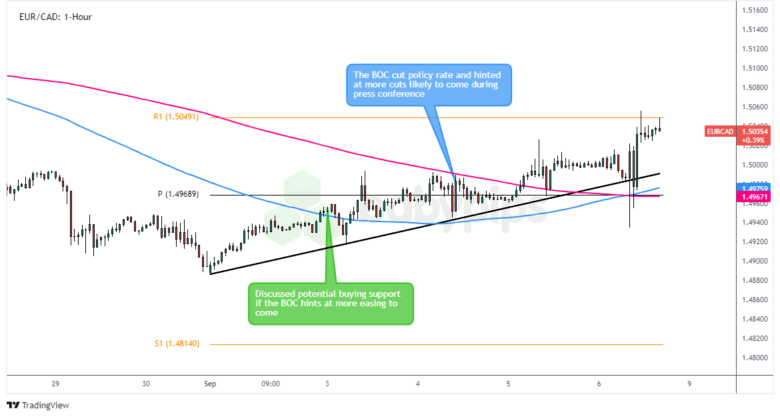This week our currency strategists focused on the U.S. ISM Manufacturing PMI data and the Bank of Canada (BOC) Monetary Policy Statement for potential high-quality setups.
Out of the four scenario/price outlook discussions this week, two discussions arguably saw both fundie & technical arguments triggered to become potential candidates for a trade & risk management overlay. Check out our review on those discussions to see what happened!
Watchlists are price outlook & strategy discussions supported by both fundamental & technical analysis, a crucial step towards creating a high quality discretionary trade idea before working on a risk & trade management plan.
If you’d like to follow our “Watchlist” picks right when they are published throughout the week, you can subscribe to BabyPips Premium.
USD/CHF 1-Hour Forex Chart by TradingView
On Monday, our forex strategists had their sights set on the upcoming U.S. ISM Manufacturing PMI release and its potential impact on the U.S. dollar. Based on our Event Guide for the ISM manufacturing PMI update, the markets were expecting a slight improvement in the index, although the reading was still likely to reflect industry contraction.
With those expectations in mind, here’s what we were thinking:
The “Dollar Dive” Scenario:
If the PMI came in as expected or lower, we figured the Fed might lean more towards an aggressive September rate cut, potentially a larger 50 basis point move. We thought that this could draw in fundamental USD sellers, and we had our eyes on USD/CHF for potential short strategies to watch given that the recent bounce in the downtrend may attract technical swing sellers, especially in a risk-off environment.
The “Greenback Gain” Scenario:
If the U.S. PMI surprised to the upside, we thought this could ease U.S. recession concerns and boost the dollar short-term. We were watching USD/JPY for if this scenario played out, as the pair’s recent behavior had been showing signs of a potential reversal from its recent downtrend, and let’s not forget the still wide interest rate policy divergence between the Fed and the Bank of Japan that may eventually re-attract carry traders.
What Actually Happened
Well, folks, Tuesday rolled around, and the U.S. ISM Manufacturing PMI decided to throw us a mixed bag of results. The August reading came in at 47.2, up from the previous month’s 46.8 but falling short of the 47.5 consensus. While this still indicated a contraction in the manufacturing sector, there were some interesting details in the report:
- The prices index advanced from 52.9 to 54.0
- The employment index improved from 43.4 to 46.0
- New orders saw another monthly decline
- Production also dropped
Timothy Fiore, chair of the ISM Manufacturing Business Survey Committee, noted, “Demand continues to be weak, output declined, and inputs stayed accommodative.” He also mentioned that companies showed an unwillingness to invest in capital and inventory due to current federal monetary policy and election uncertainty.
Market Reaction
The initial market reaction was somewhat muted, as traders digested the mixed signals from the report. Looking at our USD/CHF chart, we can see that the pair initially saw a small bounce following the PMI release, climbing from around the 0.8460 level towards the 38.2% Fibonacci retracement near 0.8480.
However, the pair’s upward momentum was short-lived. The slightly better-than-previous but still contractionary PMI reading, combined with the decline in new orders and production, seemed to reinforce the narrative of a slowing U.S. economy. This, in turn, fueled speculation about potential Fed rate cuts, putting pressure on the dollar.
As the week progressed, USD/CHF continued its descent, breaking below the S1 pivot point (0.8427) and reaching towards the S2 level (0.8358). The pair found some support around the 0.8400 psychological level, but the overall trend remained bearish.
Interestingly, the USD/CHF’s downward trajectory was further reinforced by additional U.S. economic data released later in the week:
- Wednesday’s JOLTS job openings figure came in weaker than expected and saw a negative revision to the previous report.
- Thursday brought a downbeat Challenger job cuts report and a lower-than-anticipated ADP non-farm employment change figure.
- Friday’s highly anticipated U.S. employment report initially caused some confusion in the markets. While the lower-than-expected job growth and downward revisions initially supported the 50 bps Fed cut narrative, the lower unemployment rate and higher wage growth led to a shift in expectations towards a 25 bps cut.
The Verdict
So, how’d we do? In our original discussion, we mentioned potential short setups on USD/CHF if the U.S. Manufacturing PMI came in weak, which it did (despite some mixed components). If that strategy was followed, it’s “highly likely” that it supported a net positive outcome, given that the market saw strong bearish momentum and closed below both discussion and event price areas at the Friday close.
For those who leaned bearish on USD/CHF when both fundamental and technical arguments were triggered on Tuesday, they likely saw the best potential return on risk. The strong downward momentum offered multiple opportunities to capitalize on the move:
- An initial entry could have been taken on the failure to break above the 38.2% Fibonacci retracement level, with a stop loss above the recent swing high.
- Traders could have added to their positions or entered on a break below the S1 pivot point (0.8427).
- More conservative traders might have waited for the break below the 0.8400 psychological level before entering, and still captured some pips before the weekend.
In all cases, the persistent bearish momentum provided ample opportunity to trail stops and capture a significant portion of the move.

EUR/CAD 1-Hour Forex Chart by TradingView
On Tuesday, our FX strategists had their sights set on the upcoming Bank of Canada Monetary Policy Statement and its potential impact on the Canadian dollar. Based on the Babypips.com Event Guide for the BOC decision, the markets were expecting a 25 basis point rate cut, with the potential for hints of more easing to come.
With those expectations in mind, here’s what we were thinking:
The “Loonie Bounce” Scenario:
If the BOC delivered just the expected 25 bps cut without strong dovish signals, we thought this could lead to a “buy the rumor, sell the news” reaction, potentially supporting the CAD. This scenario aligned with GBP/CAD’s recent downtrend and textbook channeling behavior pattern on the 1-hour chart.
The “Loonie Dive” Scenario:
If the BOC cut rates and signaled a more aggressive easing cycle ahead, we anticipated this could weigh on the CAD. We eyed EUR/CAD for potential long strategies, especially given its position near a long-term support area and the formation of consolidation that could lead to buying momentum on an upside breakout.
What Actually Happened
Well, folks, Wednesday rolled around, and the Bank of Canada decided to serve up a mixed platter that would make even the most seasoned forex chef scratch their head. As expected, the BOC cut its target for the overnight rate by 25 basis points to 4.25%, marking the second consecutive rate cut in its monetary policy cycle.
Key points from the BOC statement and press conference:
- The global economy expanded by about 2.50% in the second quarter, in line with July projections.
- Canada’s economy grew by 2.1% in Q2, slightly stronger than forecast.
- Inflation slowed further to 2.5% in July, with core inflation measures averaging around 2.5%.
- High shelter price inflation remains the biggest contributor to total inflation but is starting to slow.
- BOC Governor Tiff Macklem emphasized that the risk of inflation becoming too weak is now factoring into rate decisions.
- Macklem stated that the BOC is “prepared” to take a “bolder step” on rate cuts if necessary.
Market Reaction
The initial market reaction to the BOC statement release saw a brief strengthening of the Canadian dollar across the board, signaling a “buy-the-rumor, sell-the-news” reaction. However, this was quickly reversed against most of the majors before the start of the next hour.
Looking at our EUR/CAD chart, we can see that the pair initially saw a small dip following the BOC release, dropping from around the 1.4970 level towards the pivot point (1.4968). However, the pair’s downward momentum was short-lived here as well.
As the press conference progressed and Governor Macklem hinted at the possibility of more aggressive easing, EUR/CAD found support and began to climb. The pair broke above the pivot point (1.4968) and the 100 SMA, triggering our bullish scenario.
The upward momentum continued, with EUR/CAD breaking through the R1 pivot level (1.5049) and reaching towards the 1.5100 psychological level. This move aligned perfectly with our “Loonie Dive” scenario, as the market priced in the potential for more rate cuts from the BOC.
Interestingly, the EUR/CAD’s upward trajectory was further reinforced by broader market dynamics:
- Risk-off flows accelerated later in the week, benefiting the euro over the commodity-linked Canadian dollar.
- Crude oil prices declined, putting additional pressure on the Loonie.
- Mixed Canadian employment data on Friday, contrasted with the dominant U.S. jobs update, added to the overall risk aversion sentiment.
The Verdict
So, how’d we do? In our original discussion, we mentioned potential long setups on EUR/CAD if the BOC signaled a more aggressive easing cycle, which it did through Governor Macklem’s comments. If that strategy was followed, it’s “highly likely” that it supported a net positive outcome, given that the market saw bullish momentum with very few pullbacks, and closed above both discussion and event price areas at the Friday close.
For those who leaned bullish on EUR/CAD when both fundamental and technical arguments were triggered on Wednesday, they likely saw the best potential return on risk. The strong upward momentum offered multiple opportunities to capitalize on the move:
- An initial entry could have been taken on the break above the pivot point (1.4968) and 100 SMA, with a stop loss below the recent swing low.
- Traders could have added to their positions or entered on a break above the R1 pivot level (1.5049).
- More conservative traders might have waited for the break above the 1.5100 psychological level before entering, and still captured some pips before the weekend.
In all cases, the persistent bullish momentum provided ample opportunity to trail stops and capture a significant portion of the move.


